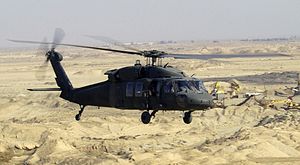Sikorsky UH-60 Blackhawk
| UH-60 Black Hawk | |
|---|---|
 |
|
| A UH-60L Black Hawk flies a low-level mission over Iraq in January 2004. | |
| Role | Utility helicopter |
| Manufacturer | Sikorsky Aircraft |
| First flight | 17 October 1974 |
| Introduction | 1979 |
| Status | In service |
| Primary users |
United States Army Japan Self Defense Forces Colombian Armed Forces Turkish Armed Forces |
| Produced | 1974–present |
| Number built | about 4,000 |
| Unit cost |
UH-60: US$21.3 million (avg. U.S. procurement, 2012)
|
| Developed from | Sikorsky S-70 |
| Variants |
Sikorsky SH-60 Seahawk Sikorsky HH-60 Pave Hawk Sikorsky HH-60 Jayhawk Mitsubishi H-60 |
| Sikorsky UH-60A Black Hawk cut-out showing internal components | |
|
|
The Sikorsky UH-60 Black Hawk is a four-bladed, twin-engine, medium-lift utility helicopter manufactured by Sikorsky Aircraft. Sikorsky submitted the S-70 design for the United States Army's Utility Tactical Transport Aircraft System (UTTAS) competition in 1972. The Army designated the prototype as the YUH-60A and selected the Black Hawk as the winner of the program in 1976, after a fly-off competition with the Boeing Vertol YUH-61.
Named after the Native American war leader Black Hawk, the UH-60A entered service with the U.S. Army in 1979, to replace the Bell UH-1 Iroquois as the Army's tactical transport helicopter. This was followed by the fielding of electronic warfare and special operations variants of the Black Hawk. Improved UH-60L and UH-60M utility variants have also been developed. Modified versions have also been developed for the U.S. Navy, Air Force, and Coast Guard. In addition to U.S. Army use, the UH-60 family has been exported to several nations. Black Hawks have served in combat during conflicts in Grenada, Panama, Iraq, Somalia, the Balkans, Afghanistan, and other areas in the Middle East.
In the late 1960s, the United States Army began forming requirements for a helicopter to replace the UH-1 Iroquois, and designated the program as the Utility Tactical Transport Aircraft System (UTTAS). The Army also initiated the development of a new, common turbine engine for its helicopters that would become the General Electric T700. Based on experience in Vietnam, the Army required significant performance, survivability and reliability improvements from both UTTAS and the new powerplant. The Army released its UTTAS request for proposals (RFP) in January 1972. The RFP also included air transport requirements. Transport aboard the C-130 limited the UTTAS cabin height and length.
...
Wikipedia
